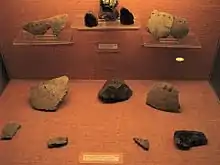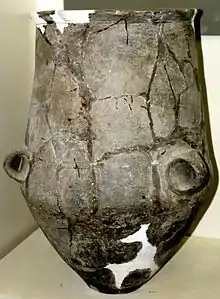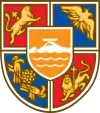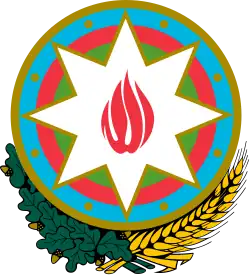 Early expansion of the Kuro-Araxes culture (light shading) shown in relation to subsequent cultures in the area, such as Urartu (dark shading). | |
| Geographical range | South Caucasus, Armenian Highlands, North Caucasus |
|---|---|
| Period | Bronze Age |
| Dates | circa 3,400 B.C.E. — circa 2,000 B.C.E. |
| Major sites | Shengavit |
| Preceded by | Shulaveri-Shomu culture |
| Followed by | Trialeti culture, Nakhchivan culture |
The Kura–Araxes culture (also named Kur–Araz culture, Mtkvari–Araxes culture, Early Transcaucasian culture) was an archaeological culture that existed from about 4000 BC until about 2000 BC,[1] which has traditionally been regarded as the date of its end; in some locations it may have disappeared as early as 2600 or 2700 BC.[2] The earliest evidence for this culture is found on the Ararat plain; it spread north in the Caucasus by 3000 BC.[3]
Altogether, the early Transcaucasian culture enveloped a vast area approximately 1,000 km by 500 km,[4] and mostly encompassed the modern-day territories of the South Caucasus (except western Georgia), northwestern Iran, the northeastern Caucasus, eastern Turkey, and as far as Syria.[5][6]
The name of the culture is derived from the Kura and Araxes river valleys. Some local variations of the Kura–Araxes culture are sometimes known as Shengavitian, Karaz (Erzurum), Pulur (after a site renamed later as Sakyol), and Yanik Tepe (Iranian Azerbaijan, near Lake Urmia) cultures.[7] It gave rise to the Khirbet Kerak-ware culture found in the Levant and Trialeti culture of the South Caucasus and Armenian Highlands. In Nakhchivan region and nearby areas, Kura-Araxes culture was followed by Nakhchivan culture.
Early history

The formative processes of the Kura-Araxes cultural complex, and the date and circumstances of its rise, have been long debated.
Shulaveri-Shomu culture preceded the Kura–Araxes culture in the area. There were many differences between these two cultures, so the connection was not clear. Later, it was suggested that the Sioni culture of eastern Georgia possibly represented a transition from the Shulaveri to the Kura-Arax cultural complex.
At many sites, the Sioni culture layers can be seen as intermediary between Shulaver-Shomu-Tepe layers and the Kura-Araxes layers.[8] This kind of stratigraphy warrants a chronological place of the Sioni culture at around 4000 BCE.[9]
Some scholars consider the Kartli and Kakheti areas as key to forming the earliest phase of the Kura–Araxes culture.[9] To a large extent, this appears as an indigenous culture of Caucasus that was formed over a long period, and at the same time incorporating foreign influences.
There are some indications (such as at Arslantepe) of the overlapping in time of the Kura-Araxes and Uruk cultures; such contacts may go back even to the Middle Uruk period.[10]
Some scholars have suggested that the earliest manifestation of the Kura-Araxes phenomenon should be dated at least to the last quarter of the 5th millennium BC. This is based on the recent data from Ovçular Tepesi, a Late Chalcolithic settlement located in Nakhchivan by the Arpaçay river.[11]

Expansion
Rather quickly, elements of Kura–Araxes culture started to proceed westward to the Erzurum plain, southwest to Cilicia, and to the southeast into the area of Lake Van, and below the Urmia basin in Iran, such as to Godin Tepe. Finally, it proceeded into the present-day Syria (Amuq valley), and as far as Palestine.
Its territory corresponds to large parts of modern Armenia, Azerbaijan, Chechnya, Dagestan, Georgia, Ingushetia, North Ossetia, and parts of Iran and Turkey.[5][6][13]
At Sos Hoyuk, in Erzurum Province, Turkey, early forms of Kura-Araxes pottery were found in association with local ceramics as early as 3500-3300 BC. During the Early Bronze Age in 3000-2200 BC, this settlement was part of the Kura-Araxes phenomenon.[14]
At Arslantepe, Turkey, around 3000 BCE, there was widespread burning and destruction, after which Kura-Araxes pottery appeared in the area.[15]
According to Geoffrey Summers, the movement of Kura-Araxes peoples into Iran and the Van region, which he interprets as quite sudden, started shortly before 3000 BC, and may have been prompted by the 'Late Uruk Collapse' (end of the Uruk period), taking place at the end of Uruk IV phase c. 3100 BC.[16]
Cultural connections
Kura–Araxes culture is closely linked to the approximately contemporaneous Maykop culture of the North Caucasus. The two cultures seem to have influenced one another.[18][19]
Economy
The economy was based on farming and livestock-raising (especially of cattle and sheep).[20] They grew grain and orchard crops, and are known to have used implements to make flour. They raised cattle, sheep, goats, dogs, and in later phases, horses.[20]
Before the Kura-Araxes period, horse bones were not found in Transcaucasia. Later, beginning about 3300 BCE, they became widespread, with signs of domestication.[21]
There is evidence of trade with Mesopotamia as well as Asia Minor.[20] It is, however, considered above all to be indigenous to the Caucasus, and its major variants characterized (according to Caucasus historian Amjad Jaimoukha) later major cultures in the region.[20]
Settlements
Archaeological evidence of inhabitants of the Kura–Araxes culture showed that ancient settlements were found along the Hrazdan river, as shown by drawings at a mountainous area in a cave nearby.[22] Structures in settlements have not revealed much differentiation, nor was there much difference in size or character between settlements,[3] facts that suggest they probably had a poorly developed social hierarchy for a significant stretch of their history. Some, but not all, settlements were surrounded by stone walls.[3] They built mud-brick houses, originally round, but later developing into subrectangular designs with structures of just one or two rooms, multiple rooms centered around an open space, or rectilinear designs.[3]
At some point the culture's settlements and burial grounds expanded out of lowland river valleys and into highland areas.[23] Although some scholars have suggested that this expansion demonstrates a switch from agriculture to pastoralism and that it serves as possible proof of a large-scale arrival of Indo-Europeans, facts such as that settlement in the lowlands remained more or less continuous suggest merely that the people of this culture were diversifying their economy to encompass crop and livestock agriculture.[23]
Shengavit Settlement is a prominent Kura-Araxes site in present-day Yerevan area in Armenia. It was inhabited from approximately 3200 BC cal to 2500 BC cal. Later on, in the Middle Bronze Age, it was used irregularly until 2200 BC cal. The town occupied an area of six hectares, which is large for Kura-Araxes sites.
Metallurgy
In the earliest phase of the Kura–Araxes culture, metal was scarce. In comparison, the preceding Leilatepe culture's metalwork tradition was far more sophisticated.[24]
The Kura–Araxes culture would later display "a precocious metallurgical development, which strongly influenced surrounding regions".[25] They worked copper, arsenic, silver, gold,[3] tin, and bronze.[23]
Their metal goods were widely distributed, from the Volga, Dnieper and Don-Donets river systems in the north to Syria and Palestine in the south and Anatolia in the west.
Pottery

Their pottery was distinctive. The spread of their pottery along trade routes into surrounding cultures was much more impressive than any of their achievements domestically.[3] It was painted black and red, using geometric designs. Examples have been found as far south as Syria and Israel, and as far north as Dagestan and Chechnya.[26] The spread of this pottery, along with archaeological evidence of invasions, suggests that the Kura-Araxes people may have spread outward from their original homes and, most certainly, had extensive trade contacts. Jaimoukha believes that its southern expanse is attributable primarily to Mitanni and the Hurrians.[20]
According to Giulio Palumbi (2008), the typical red-black ware of Kura–Araxes culture originated in eastern Anatolia, and then moved on to the Caucasus area. But then these cultural influences came back to Anatolia mixed in with other cultural elements from the Caucasus.[27]
Viticulture
Viticulture and wine-making were widely practised in the area from the earliest times. Viticulture even goes back to the earlier Shulaveri-Shomu culture.
The earliest evidence of domesticated grapes in the world has been found at Gadachrili Gora, near the village of Imiri, Marneuli Municipality, in southeastern Republic of Georgia; carbon-dating points to the date of about 6000 BC.[28][29]
Grape pips dating back to the V-IVth millennia BC were found in Shulaveri; others dating back to the IVth millennium BC were found in Khizanaant Gora—all in this same 'Shulaveri area' of the Republic of Georgia.[30]
A theory has been suggested by Stephen Batiuk that the Kura-Araxes folk may have spread Vitis vinifera vine and wine technology to the "Fertile Crescent"—to Mesopotamia and the Eastern Mediterranean.[31] The spread of the wine-goblet form, such as represented by the Khirbet Kerak ware, is clearly associated with these peoples. The same applies to the large ceramic vessels used for grape fermentation.
Burial customs

Inhumation practices are mixed. Flat graves are found but so are substantial kurgan burials, the latter of which may be surrounded by dolmen. This points to a heterogeneous ethno-linguistic population (see section below).
Analyzing the situation in the Kura-Araxes period, T. A. Akhundov notes the lack of unity in funerary monuments, which he considers more than strange in the framework of a single culture; for the funeral rites reflect the deep culture-forming foundations and are weakly influenced by external customs. There are non-kurgan and kurgan burials, burials in ground pits, in stone boxes and crypts, in the underlying ground strata and on top of them; using both the round and rectangular burials; there are also substantial differences in the typical corpse position.[33] Burial complexes of Kura–Araxes culture sometimes also include cremation.[34]
Here one can come to the conclusion that the Kura–Araxes culture developed gradually through a synthesis of several cultural traditions, including the ancient cultures of the Caucasus and nearby territories.
Late Kura-Araxes sites often featured Kurgans of greatly varying sizes, with larger, wealthier kurgans surrounded by smaller kurgans containing less wealth. These kurgans also contained a wide assortment metalworks.[2] This trend suggests the eventual emergence of a marked social hierarchy.[2] Their practice of storing relatively great wealth in burial kurgans was probably a cultural influence from the more ancient civilizations of the Fertile Crescent to the south.[2]
In the 3rd millennium B.C., one particular group of mounds of the Kura–Araxes culture is remarkable for their wealth. This was the final stage of culture's development. These burial mounds are known as the Martqopi (or Martkopi) period mounds. Those on the left bank of the river Alazani are often 20–25 meters high and 200–300 meters in diameter. They contain especially rich artefacts, such as gold and silver jewelry.[35]
Ethno-linguistic makeup
While it is unknown what languages were present in Kura-Araxes, the two most widespread theories suggest a connection with Hurro-Urartian[36][37][38][39] and/or Anatolian languages.[40][41][42][43][44] The Kartvelian[45] and Northeast Caucasian languages[46] were likely spoken in the region as well.
See also
| Part of a series on the |
| History of Georgia |
|---|
.jpg.webp) |
| History of Armenia |
|---|
 Coat of Arms of Armenia |
| Timeline • Origins • Etymology |
| History of Iran |
|---|
 |
|
Timeline |
References
- ↑ The early Trans-Caucasian culture, I.M. Diakonoff, 1984
- 1 2 3 4 Edens, Christoper (Aug–Nov 1995). "Transcaucasia at the End of the Early Bronze Age". Bulletin of the American Schools of Oriental Research. The American Schools of Oriental Research. 299/300 (The Archaeology of Empire in Ancient Anatolia): 53, pp. 53–64 [56]. doi:10.2307/1357345. JSTOR 1357345. S2CID 163585471.
- 1 2 3 4 5 6 Edens, Christoper (Aug–Nov 1995). "Transcaucasia at the End of the Early Bronze Age". Bulletin of the American Schools of Oriental Research. The American Schools of Oriental Research. 299/300 (The Archaeology of Empire in Ancient Anatolia): 54. doi:10.2307/1357345. JSTOR 1357345. S2CID 163585471.
- ↑ The Hurro-Urartian people – John A.C. Greppin
- 1 2 K. Kh. Kushnareva. [The Southern Caucasus in Prehistory: Stages of Cultural and Socioeconomic Development from the Eighth to the Second Millennium B.C." UPenn Museum of Archaeology, 1 Jan. 1997. ISBN 0-924171-50-2 p 44
- 1 2 Antonio Sagona, Paul Zimansky. "Ancient Turkey" Routledge 2015. ISBN 1-134-44027-8 p 163
- ↑ Rothman, Mitchell S. (2015). "Early Bronze Age migrants and ethnicity in the Middle Eastern mountain zone". Proceedings of the National Academy of Sciences. 112 (30): 9190–9195. Bibcode:2015PNAS..112.9190R. doi:10.1073/pnas.1502220112. PMC 4522795. PMID 26080417.
- ↑ Kighuradze T. 1998:19
- 1 2 Guram Mirtskhulava, Guram Chikovani, PHASE OF TRANSITION TO THE KURA-ARAXES CULTURE IN EASTERN GEORGIA. Problems of Early Metal Age Archaeology of Caucasus and Anatolia. Proceedings of International Conference. Tbilisi, 2014
- ↑ Giorgi Leon Kavtaradze (2012), On the Importance of the Caucasian Chronology for the Foundation of the Common Near Eastern – East European Chronological System
- ↑ C. MARRO, R. BERTHON, V. BAKHSHALIYEV, On the Genesis of the Kura-Araxes phenomenon: New evidence from Nakhchivan (Azerbaijan). in The Kura-Araxes culture from the Caucasus to Iran, Anatolia and the Levant: Between unity and diversity. Paléorient 40.2 – 2014, C. Chataigner et G. Palumbi, eds. CNRS Édidtions ISBN 978-2-271-08271-8
- ↑ Wang, Chuan-Chao (2016). "Ancient human genome-wide data from a 3000-year interval in the Caucasus corresponds with eco-geographic regions". Nature Communication.
- ↑ Encyclopedic Dictionary of Archaeology – Page 246 by Barbara Ann Kipfer
- ↑ Kibaroğlu, Mustafa; Sagona, Antonio; Satir, Muharrem (2011). "Petrographic and geochemical investigations of the late prehistoric ceramics from Sos Höyük, Erzurum (Eastern Anatolia)". Journal of Archaeological Science. 38 (11): 3072–3084. Bibcode:2011JArSc..38.3072K. doi:10.1016/j.jas.2011.07.006.
- ↑ Frangipane, Marcella (2015). "Different types of multiethnic societies and different patterns of development and change in the prehistoric Near East". Proceedings of the National Academy of Sciences. 112 (30): 9182–9189. Bibcode:2015PNAS..112.9182F. doi:10.1073/pnas.1419883112. PMC 4522825. PMID 26015583.
- ↑ Geoffrey D. Summers, The Early Trans-Caucasian Culture in Iran: Perspectives and problems. Paléorient 2014 Volume 40 Numéro 2 pp. 155-168
- ↑ Jeong, Choongwon; Wang, Ke; Wilkin, Shevan (12 November 2020). "A Dynamic 6,000-Year Genetic History of Eurasia's Eastern Steppe". Cell. 183 (4): 890–904, Figure 1 A, B, C. doi:10.1016/j.cell.2020.10.015. hdl:21.11116/0000-0007-77BF-D. ISSN 0092-8674.
- ↑ Antonio Sagona. Rethinking the Kura-Araxes Genesis. (2014). pp. 26
- ↑ Philip L. Kohl.The Making of Bronze Age Eurasia. pp. 74, 82
- 1 2 3 4 5 Jaimoukha, Amjad. The Chechens. Pages 25-6
- ↑ David W. Anthony, The Horse, the Wheel, and Language: How Bronze-Age Riders from the Eurasian Steppes Shaped the Modern World. Princeton University Press, 2010 ISBN 1400831105 p298
- ↑ Encyclopedia of the Peoples of Africa and the Middle East: L to Z. page 52 by Jamie Stokes
- 1 2 3 Edens, Christoper (Aug–Nov 1995). "Transcaucasia at the End of the Early Bronze Age". Bulletin of the American Schools of Oriental Research. The American Schools of Oriental Research. 299/300 (The Archaeology of Empire in Ancient Anatolia): 55. doi:10.2307/1357345. JSTOR 1357345. S2CID 163585471.
- ↑ Tufan Isaakoglu Akhundov, AT THE BEGINNING OF CAUCASIAN METALLURGY. Problems of Early Metal Age Archaeology of Caucasus and Anatolia. Proceedings of International Conference. Tbilisi 2014
- ↑ Mallory, James P. (1997). "Kuro-Araxes Culture". Encyclopedia of Indo-European Culture. Fitzroy Dearborn: 341–42.
- ↑ The Pre-history of the Armenian People. I. M. Diakonoff
- ↑ D. T. Potts (2012). A Companion to the Archaeology of the Ancient Near East. John Wiley & Sons. p. 677. ISBN 978-1-4443-6077-6.
- ↑ Nana Rusishvili, The grapevine Culture in Georgia on Basis of Palaeobotanical Data. Archived 2016-03-04 at the Wayback Machine "Mteny" Association, 2010
- ↑ Peter Boisseau, How wine-making spread through the ancient world: U of T archaeologist. June 17, 2015 – news.utoronto.ca
- ↑ Malkhaz Kharbedia, THE HISTORY OF GEORGIAN WINE 01/20/2015
- ↑ Batiuk, Stephen D. (2013). "The fruits of migration: Understanding the 'longue dureé' and the socio-economic relations of the Early Transcaucasian Culture". Journal of Anthropological Archaeology. 32 (4): 449–477. doi:10.1016/j.jaa.2013.08.002.
- ↑ Wang, Chuan-Chao (2016). "Ancient human genome-wide data from a 3000-year interval in the Caucasus corresponds with eco-geographic regions". Nature Communication.
- ↑ Севда Сулейманова, ДРЕВНЕЙШИЕ ЭКОНОМИЧЕСКИЕ И КУЛЬТУРНЫЕ СВЯЗИ В БЛИЖНЕВОСТОЧНО-КАВКАЗСКОМ АРЕАЛЕ Баку 2011
- ↑ А.И. Мартынов, Кавказский центр металлургии. Культуры долин и гор 5-е изд., перераб. - М.: Высш. шк., 2005
- ↑ Konstantine Pitskhelauri (2012). "Uruk Migrants in the Caucasus" (PDF). Bulletin of the Georgian National Academy of Sciences. 6 (2). Archived from the original (PDF) on 2013-10-07.
- ↑ John A. C. Greppin and I. M. Diakonoff. Some Effects of the Hurro-Urartian People and Their Languages upon the Earliest Armenians.(1991) pp. 720-730.
- ↑ Charles Burney. Historical Dictionary of the Hittites. (2004) pp. 129.
- ↑ Marilyn Kelly- Buccellati. Andirons at Urkesh: New Evidence for the Hurrian Identity of the Early Trans-Caucasian Culture. (2004)
- ↑ Alexei Kassian. Lexical Matches between Sumerian and Hurro-Urartian: Possible Historical Scenarios. (2014)
- ↑ Petra Goedegebuure. Anatolians on the Move: From Kurgans to Kanesh. 2020.
- ↑ Renfrew, A. C., 1987, Archaeology and Language: The Puzzle of Indo-European Origins, London: Pimlico. ISBN 0-7126-6612-5
- ↑ T. V. Gamkrelidze; V. V. Ivanov (March 1990). "The Early History of Indo-European Languages". Scientific American. Vol. 262, no. 3. pp. 110–116. Archived from the original on 2014-01-06.
- ↑ Renfrew, Colin (2003). "Time Depth, Convergence Theory, and Innovation in Proto-Indo-European". Languages in Prehistoric Europe. Winter. ISBN 978-3-8253-1449-1.
- ↑ James P. Mallory, "Kuro-Araxes Culture", Encyclopedia of Indo-European culture, Fitzroy Dearborn, 1997.
- ↑ David Anthony. The Horse, the Wheel, and Language: How Bronze-Age Riders from the Eurasian Steppes Shaped the Modern World (2007). P. 98.
- ↑ Kavtaradze, Giorgi. "The Chronology of the Caucasus during the Early Metal Age: Observations from Central Trans-Caucasus, – A View from the Highlands. Archaeological Studies in Honour of Charles Burney. Edited by Antonio Sagona. (Ancient Near Eastern Studies, Supplement 12). Leuven: Peeters, 2004, pp. 539-556. ISBN 90-429-1352-5".
Sources
- Stephen Batiuk, Mitchell Rothman, Early Transcaucasian Cultures and Their Neighbors. Archived 2015-09-16 at the Wayback Machine University Museum of the University of Pennsylvania: Expedition, 2007
- Mascarenhas, Desmond D.; Raina, Anupuma; Aston, Christopher E.; Sanghera, Dharambir K. (2015), "Genetic and Cultural Reconstruction of the Migration of an Ancient Lineage", BioMed Research International, 2015: 1–16, doi:10.1155/2015/651415, PMC 4605215, PMID 26491681
- James P. Mallory, "Kuro-Araxes Culture", Encyclopedia of Indo-European culture, Fitzroy Dearborn, 1997.
- Pamjav (2012), "Brief communication: New Y-chromosome binary markers improve phylogenetic resolution within haplogroup R1a1", American Journal of Physical Anthropology, 149 (4): 611–615, doi:10.1002/ajpa.22167, PMID 23115110
- Underhill, Peter A.; et al. (2015), "The phylogenetic and geographic structure of Y-chromosome haplogroup R1a", European Journal of Human Genetics, 23 (1): 124–131, doi:10.1038/ejhg.2014.50, PMC 4266736, PMID 24667786
- Rothman, Mitchell S. (2015). "Early Bronze Age migrants and ethnicity in the Middle Eastern mountain zone". Proceedings of the National Academy of Sciences. 112 (30): 9190–9195. Bibcode:2015PNAS..112.9190R. doi:10.1073/pnas.1502220112. ISSN 0027-8424. PMC 4522795. PMID 26080417.
External links
- Giorgi L. Kavtaradze, The Chronology of the Caucasus During the Early Metal Age: Observations from Central Transcaucasus Archived 2016-03-04 at the Wayback Machine 2004. (alternative site)
- Kura-Arax Pottery – Karnut I (2900-2500 BC) Archived 2013-11-14 at the Wayback Machine The Kura-Arax Pottery Technology Database (KAPTech)
- The Beginnings of Metallurgy – includes extensive discussion of Kura-Araxes metalworking
- Toby Wilkinson (2009), Pathways and highways: routes in Bronze Age Eurasia, ArchAtlas, Version 4.1 – Accessed: 9 November 2015
- Dieneke's Anthropology Blog (2013), Origin of Early Transcaucasian Culture (aka Kura-Araxes culture)
- Shengavit - a Kura Araxes Culture Site in Yerevan on the Ararat hills, Republic of Armenia. By Hakop Simonyan, 2000-2008 season field director
- Problems of Early Metal Age Archaeology of Caucasus and Anatolia. Proceedings of International Conference; November 19–23, 2014, Georgia; edited by G. Narimanishvili. Tbilisi, 2014 305 pages ISBN 9789941071348
- The spatial organization of craft production at the Kura-Araxes settlement of Köhne Shahar in northwestern Iran: A zooarchaeological approach - PLOS ONE March 4, 2020 - Siavash Samei and Karim Alizadeh
.png.webp)

